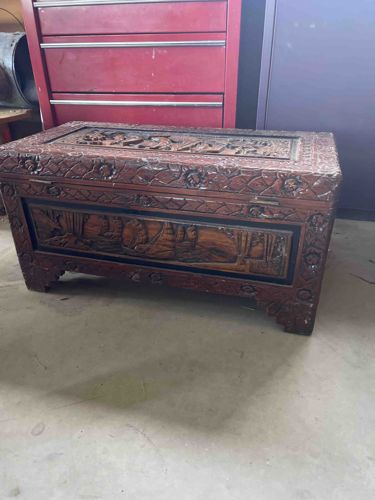
Carved Camphor Wood Chest
This is a rectangular-shaped carved camphor wood chest, likely of East Asian origin, possibly Chinese, characterized by its reddish-brown finish and extensive relief carving. The overall dimensions appear to be that of a medium-sized blanket chest or coffee table chest. The chest is constructed from wood, likely camphor wood due to its traditional use for such items and its rich color, with a darker stain or finish applied to enhance the carved details. The top lid features a large central carved panel depicting a detailed scene, possibly of figures engaged in a landscape or narrative, surrounded by a border of intricate floral or geometric patterns. The front and side panels also display similar elaborate carving, showcasing scenes with figures, foliage, and architectural elements, demonstrating a high level of craftsmanship. The central carved sections on the front and sides are set against a darker, recessed background, creating depth and contrast. The chest stands on four short, splayed feet, which are also carved and integrate seamlessly with the base design. Notable features include the detailed 'busy' carving style, typical of export chests from the early to mid-20th century. The visible condition shows signs of age and wear, including some scuffs, scratches, and possible fading or chipping of the finish, particularly on raised carved areas and edges. There might be some dust accumulation in the crevices of the carving. The hardware, such as hinges and possible latch, is not clearly visible but would be functional to the chest's operation. No specific maker's marks or signatures are discernible from the provided images. The style suggests a revival of traditional Chinese carving techniques, intended for both practical storage and decorative display. The quality of the carving appears fine, with good attention to detail in the figures and landscape elements. The chest exemplifies traditional woodworking and carving artistry, possibly dating from the 1920s-1950s.
AI-Generated Appraisal Disclaimer
Estimated Value
$400-700
Basic Information
Category
Furniture
Appraised On
November 27, 2025
Estimated Value
$400-700
Item Description
This is a rectangular-shaped carved camphor wood chest, likely of East Asian origin, possibly Chinese, characterized by its reddish-brown finish and extensive relief carving. The overall dimensions appear to be that of a medium-sized blanket chest or coffee table chest. The chest is constructed from wood, likely camphor wood due to its traditional use for such items and its rich color, with a darker stain or finish applied to enhance the carved details. The top lid features a large central carved panel depicting a detailed scene, possibly of figures engaged in a landscape or narrative, surrounded by a border of intricate floral or geometric patterns. The front and side panels also display similar elaborate carving, showcasing scenes with figures, foliage, and architectural elements, demonstrating a high level of craftsmanship. The central carved sections on the front and sides are set against a darker, recessed background, creating depth and contrast. The chest stands on four short, splayed feet, which are also carved and integrate seamlessly with the base design. Notable features include the detailed 'busy' carving style, typical of export chests from the early to mid-20th century. The visible condition shows signs of age and wear, including some scuffs, scratches, and possible fading or chipping of the finish, particularly on raised carved areas and edges. There might be some dust accumulation in the crevices of the carving. The hardware, such as hinges and possible latch, is not clearly visible but would be functional to the chest's operation. No specific maker's marks or signatures are discernible from the provided images. The style suggests a revival of traditional Chinese carving techniques, intended for both practical storage and decorative display. The quality of the carving appears fine, with good attention to detail in the figures and landscape elements. The chest exemplifies traditional woodworking and carving artistry, possibly dating from the 1920s-1950s.
Related Tags
Get Your Items Appraised
Instant estimates of your treasures with AI-powered instant appraisals